Croatian Island Movement Accepted into European Small Islands Federation
October the 7th, 2022 - The Croatian Island Movement (Pokret otoka), which works to take care of and further improve the needs of the inhabitants of Croatia's many islands, has been accepted into the European Small Islands Federation.
As Morski writes, at a recently held meeting of the Board of Directors of the European Federation of Small Islands (ESIN), the decision to accept the Croatian Island Movement as a representative of Croatia's islands was confirmed.
On September the 7th and 8th, the Croatian Island Movement participated as an observer during the ESIN annual assembly which was held on the Estonian island of Kihnu, at which the proposal of the president of the federation, John Walsh, to admit a new organisation from the Republic of Croatia to membership was accepted.
After the unanimous support of the Assembly, composed of representatives of the Finnish, Aland, Swedish, Danish, Irish, Scottish and French islands, the Croatian Island Movement became a full member of the ESIN, cemented by recent participation with the Board of Directors.
The ESIN is otherwise a European organisation founded back in 2001 with its official headquarters located in Sweden, and it brings together the representatives of over 1,500 small European islands which are home to over 350,000 islanders in total.
As a network of islanders, the federation enables the exchange of experiences, knowledge and best practices at the local level, advocates and develops a new approach to island development policies, and is the voice of small island communities at the European Union (EU) level. As the Croatian representative, Island Movement (Pokret otoka) will continue to promote the importance of sustainable development, community work and a bottom-up approach to development policies in and through the ESIN.
For more, make sure to check out our dedicated lifestyle section.
Big Plans: HRK 452m Bridge to Connect Pašman Island to Mainland
September 25, 2022 - Zadar County has included the project of connecting the island of Pašman to the mainland in the spatial plan as one of their priorities. The will is there, but it is not yet known how and from where this project would be financed, Hina was told by the Ministry of the Sea, Transport, and Infrastructure.
As reported by Poslovni, the ministry points out that for the project of connecting the island of Pašman to the mainland, a feasibility study with a cost-benefit analysis was prepared in 2021 for the project "Bridge to mainland - island of Pašman with access roads to the bridge." Based on the demand analysis of the traffic model, the main goal of the study was to select the best option for connecting the island of Pašman and the mainland.
According to the ministry, the study evaluated building a beam bridge as the best option, consisting of two parts, the first of which would go from Pašman to the islet of Ričul, and from Ričul to the mainland. The estimated value of the project is almost HRK 452 million.
On the mainland side, the bridge should be connected by state road D8 with the future bypass Zadar - Pakoštane, and the route exits to the very bank of the Pašman channel at the position of cape Tukljača.
From the mainland, the planned route goes to the islet of Ričul, about 400 meters from the coast, and continues towards Pašman, crossing the Pašman channel in a length of about 1400 meters. On the island of Pašman, the route continues, via the junction, to the state road D110, thus connecting the bridge with the main road of the islands of Pašman and Ugljan. The bridge's total length would be 2203 and a half meters, and the construction, according to the projections, would last about three years.
The recently opened Pelješac Bridge is slightly more than 2,400 meters long. The project's total value is estimated at 420 million euros, including the construction of the bridge, access roads, and the Ston bypass.
"The fact is that Zadar County has included the mentioned project in the spatial plan as one of the priorities and that the preparation of the documentation has started; however, we would like to note that the mentioned pre-feasibility study needs to be elaborated in more detail, especially concerning the preparation of technical documentation, i.e., more detailed elaboration of investment and operational costs," said the Ministry of the Sea, Transport and Infrastructure. They also point out that the future source of financing should be determined for the chosen option, given that it is not eligible for co-financing from EU funds, so in this context, they cannot say anything more at the moment.
By the way, the Pašman - mainland bridge, for which the Municipality of Pašman received the support of the Ministry of the Sea, Transport and Infrastructure, is one of the most important projects for the island of Pašman, but also for Ugljan, which is connected to Pašman by a smaller bridge. The Ministry of Transport financed the pre-feasibility study with HRK 700,000, prepared by the international company Ernst & Young Consulting.
Interestingly, representatives of the Chinese company China Road and Bridge Corporation, which built the Pelješki bridge within the given deadline, once visited the municipality of Pašman to learn about the possibilities of building a bridge that would connect Pašman to the mainland. The representatives of the Chinese company said then that the bridge could be completed relatively quickly with a professional and thoughtful project. It is also not unimportant that the rocky bottom and suitable depth of about 13 meters on average would make this bridge much cheaper than the Pelješac one.
If it is built, the bridge could stop the depopulation of the two islands, and the price of land would increase, but some residents fear that the scenario of the rebuilt Vir could happen, where the bridge did not bring much good in terms of tourism.
The municipality of Pašman has embarked on a project to build the Pašman - mainland bridge, which for all islanders means an increase in the quality of life through a better connection with the mainland and a significant positive impact on the economy of the entire municipality, said the former mayor of the municipality of Pašman, Krešimir Ćosić, who believes that this project will be successful. For the municipality of Pašman, it is a strategic project, the realisation of which would provide even better opportunities for residents to stay in their hometowns. Ćosić recently said that only the islands connected to the mainland have an increase in population and that the construction of a permanent link would lead to new employment and lower living costs on the island.
Therefore, the Pašman bridge would connect the island of Ugljan with the mainland since Ugljan and Pašman, which together have about 8,000 residents, are already connected by the mentioned bridge in Ždrelac. There is even a detailed bridge construction project, and complete technical documentation made twenty years ago at the Faculty of Civil Engineering in Zagreb.
The mayor of the municipality of Kukljica, one of the most developed tourist towns in Ugljan, Marin Boško, points out that in his town, there are more people in favour of the construction of the bridge than against it. "There are more pros for that construction than cons," said Boško for Hina. He points out that the prices of land and real estate would rise, and depopulation would probably stop in the long term.
As the main problem of the eventual construction of the Pašman Bridge, he points out the infrastructure that would not be able to handle significantly more tourists on the islands. "Infrastructure would have to be strengthened on both islands - both on Pašman and Ugljan, and by that, I mean water infrastructure, sewage, better access roads," said Boško, adding that the Pašman bridge would bring a lot of good, not only to tourism, which the bridge would further develop. "If we had a bridge, we could reach the mainland at any time, emergencies would not depend on ferries, and more people from the island could work on the mainland and travel more easily every day," concluded Boško.
For more, make sure to check out our dedicated Lifestyle section.
Planet Brusnik: Funds for Development of Island of Volcanic Origin Approved
August the 21st, 2022 - Funds for the proper development of one of two Croatian islands of volcanic origin have now been approved. The Planet Brusnik project is likely to impress.
As Morski writes, Split-Dalmatia County approved the necessary financial resources for the Geopark Vis Archipelago, more precisely for the "Planet Brusnik" project, which should contribute to the promotion and preservation of the area's overall natural history and heritage through the creation of educational materials and a workshop on the traditional skill of dry-wall construction.
On top of all of the aforementioned, a very special tourist experience will be the sailing of workshop participants on a traditional Komi boat, as the park's management team announced.
The island of Brusnik is located about thirteen nautical miles away from the popular Komiza in the west-southwest direction. Although its area is only small, spanning a mere 0.049 square kilometres in total, Brusnik is highly specific because of its geological, natural, cultural and historical heritage. Back in 1951, it was first listed as protected as a geological monument of nature due to the magmatic origin of the rocks from which it was formed, which is a great rarity in the Adriatic Sea since the islands in these waters are mainly formed from carbonate rocks such as limestone and dolomite. The island of Brusnik and the island of Jabuka are the only Adriatic islands made from igneous rocks.
Brusnik is an island that "grows", and we can find conglomerates of pebbles all the way to the top of the island, which indicates a recent uplift of the island. Brusnik's pebbles and stones are entirely made up of grey deposits of diabase (a type of igneous rock) of various sizes that are overgrown with algae from the sea, which gives this unique place on the Adriatic an extraterrestrial colour of sorts.
In the middle of the island there is a gorge with a depression filled by the sea, which the local fishermen from nearby Komiza took advantage of and created basins with sea water out of handy larger pebbles for keeping hold of things they'd caught, including lobsters.
On Brusnik's large slope, you can see the remains of fishermen's houses built from large diabase pebbles using the dry-wall construction method which is both typical and traditional all over both mainland Dalmatia and on Dalmatian islands. Such miniature houses and shelters, once covered with pine branches from the nearby island of Sveca, served as places for salting bluefish in barrels and as shelter for fishermen from the harsh elements such as the beating sun and winds. There are several endemic species on the island, among which the most famous is the Brusnik black lizard.
The island of Brusnik otherwise belongs to the NATURA 2000 ecological network, and since back in 2019 it has been protected by the UNESCO label.
For more, make sure to check out our dedicated lifestyle section.
Beginning of Hvar Main Tourist Season Excellent So Far
June the 14th, 2022 - The beginning of the Hvar main tourist season has been excellent so far, with the Suncani Hvar hotel chain rubbing their hands with satisfaction.
With two pandemic-dominated years causing issues and very valid concerns among all those working within the country's most economically powerful sector - tourism, continuing news about excellent tourist numbers during the pre-season and now during the beginning of the height of the summer season are more than welcome.
As Morski writes, things are looking great for the Hvar main tourist season, as there are 1,200 tourists in the aforementioned company's hotels, reservations so far have been very good, and June so far is better than the pre-pandemic June of 2019.
The current visitors to the beautiful island of Hvar come from all over Europe, including Spain, Britain, and Germany. Tourists accustomed to inflation in their own countries are no longer bothered by the current higher Croatian prices, and they aren't complaining about ferry ticket prices or about prices in restaurants and cafes.
''The prices are completely fair,'' said one tourist.
''Hotel occupancy is over 90 percent, most guests at the moment have come from the markets of the United States, Great Britain and other European countries, and in principle they are all guests of higher purchasing power. They stay 3 to 4 days, they like to eat and drink well and they also like excursions and boats,'' explained one employee of the Suncani Hvar hotel chain.
While Hvar has been doing well to gradually begin moving away from its title of the ''Croatian Ibiza'', this Central Dalmatian island continues to be a mecca of good fun. Nightclubs and beach bars are still recovering from the coronavirus-induced damage and are expanding when it comes to their offer.
Everything is ready for another Hvar main tourist season during which this popular island will surely be at the top of various top destinations, both in a global and European sense.
For more, make sure to check out our dedicated travel section.
Islands of the World Conference Opens in Zadar
ZAGREB, 13 June 2022 - The 18th Islands of the World Conference - Islands: Nature and Culture, organised within the International Small Islands Studies Association (ISISA), has opened at the University of Zadar, bringing together 120 scientists and other participants from Croatia and nearly all continents.
The programme is extremely rich, University Rector Dijana Vican said in her opening remarks on Monday, noting that small islands would be approached from different scientific points of view.
According to most world classifications, all Croatian islands, which are rich in cultural heritage and various archaeological sites, are small islands. These areas are natural-geographical phenomena that have an important role in modern socio-economic development, especially tourism.
In the last decades, Croatian islands have undergone many negative processes, such as depopulation, population ageing and economic transformation, which have threatened their sustainable development and many important traditional cultural landscapes.
State Secretary Šime Erlić, who opened the conference on behalf of Prime Minister Andrej Plenković, said that islands were of special interest to this government, which didn't mean that all island problems could be resolved easily.
Although the island population has been growing over the past 10 years, due to the pandemic and energy crisis we have reached a moment when life on an island is becoming unbearably difficult. The biggest challenge is to preserve natural heritage and the ecosystem on the one hand, and on the other hand to enable citizens to live in dignity, which means investments and attracting investors, says Erlić.
For more, check out our lifestyle section.
Zlarin Island Has Least Plastic, Most Waste Separation on Krk Island
June the 12th, 2022 - Zlarin island has the least plastic waste among the country's many inhabited islands, while the island of Krk does the best job when it comes to waste separation.
As Morski writes, the Sunce Association organised another study trip as part of the project entitled "For Plastic-Free Croatian Islands". This time, the employees of the Sunce Association, along with their project partners, visited the island with the least plastic, Zlarin island, and the island with the highest percentage of waste separation in all of Croatia, Krk.
The first day of the trip was a visit to Zlarin island, which launched the initiative to reduce plastic waste on that particular island four years ago.
''Through the initiative For Zlarin island without plastic, significant progress has been made in reducing pollution as a result of disposable plastic. The project was initially supported by the Tourist Board and the local mayor, and then slowly began to involve local traders, fishermen and other locals,'' said Katarina Gregov, a representative of the Zlarin Tourist Board.
The mere fact that there are no cars on Zlarin island is a sufficient motivator for the local community to continue striving to develop the concept of sustainable tourism by which visitors have the opportunity to experience the island as it always has been throughout time.
''Our goal is to make people aware of being more responsible consumers and not replacing one type of waste with another. In the beginning, of course, it wasn't easy, it's difficult to change people's already well established habits and patterns of behaviour. However, when you provide them with some education, and at the same time an acceptable and affordable alternative to disposable plastic, most of them eventually agree to it,'' said Katarina.
Krk - the island with the highest percentage of separated waste in all of Croatia
The second and third day of the trip saw the aforementioned Association head to the beautiful island of Krk, the most populated and economically developed island in the country, and also one of the Croatian leaders in the share of separation of useful raw materials from waste.
For many years, Krk has been implementing a system of a circular economy, which doesn't discard raw materials, but instead uses them for re-production. This reduces the consumption of limited natural resources (oil, wood, iron) and, consequently, waste.
Waste is collected door to door, and Krk's residents have bins in front of their houses in order to separate plastic, glass, paper, biowaste and mixed municipal waste themselves. However, the door-to-door waste collection system wasn't introduced in the old town due to the mayor's decision not to have bins located there, nor air conditioning, clotheslines, etc. That means that waste from the old town is collected outside the of the walls in special locations.
A large amount of separately-collected recyclable waste comes mixed, so this waste is first taken to a sorting plant where it's further sorted, baled and handed over for further recovery. Additional waste sorting is important when it comes to separating waste that doesn't belong there. In addition, waste sorting plants are important for the future self-financing of utility companies because they further reduce the cost of waste collection.
Krk is also proud of its modernly equipped composting plant, in which about six million kuna was invested two years ago for the modernisation of the plant. The space of the once open composting plant, after the investment, was covered and closed, and a device for machining the imported biowaste was installed in it. Produced compost is 1st class compost used for agricultural purposes, and users of Ponikve Krk's services receive one bag of that compost as a gift, while larger quantities are sold at a very affordable price and brought to the doorstep. Ponikve Krk also plans to produce third class compost from sludge from wastewater in the amount of 676 tonnes of compost per year.
For more, make sure to check out our dedicated lifestyle section.
Massive 52 Million Euro Project to Begin Transformation of Vis Island
June the 10th, 2022 - A massive 52 million euro project is set to begin the transformation of gorgeous Vis island, bringing it up to a far higher level when it comes to tourism.
As Poslovni Dnevnik/Marija Crnjak writes, with a huge investment of 52 million euros in the construction of a new exclusive hotel in Komiza and bringing Marriott's lifestyle brand Autograph Collection to the Republic of Croatia for the veru first time, the company Modra spilja (with the majority shareholder being PFZ Croatia osiguranje) will initiate the transformation of Vis island.
On the site of the bulky concrete building of the current two-star Hotel Bisevo, Komiza will get a five-star hotel that will fit entirely into the surrounding natural environment and the view of the city, and a promenade by the sea which will soon be walked along by some new guests, the users of Marriott's loyalty club.
In addition to the investor, the architectural studio 3LHD, the Bruketa & Zinic & Gray agency and the company Hotel & Destination Consulting have all been engaged in the realisation of this project, which has been underway for the last year now.
"Our goal on Vis island is to develop a high value-added tourism product, with a globally recognisable hotel brand that guarantees standards recognised around the world, in order to better capitalide on this remote and unique destination. We simply want to take advantage of the distance and harder accessibility of this destination which is ideal for an escape from reality, for wellbeing, and for the recovery of both body and mind from hectic lifestyles.
Autograph is ideal for such a product, because it's a brand in which each hotel is different, it has its own special story that is usually related to local culture or traditions, and the content is related to that,'' explained Mario Radakovic, a member management of the company Modra spilja.
As it is known, the pension fund PBZ CO paid its creditors back in 2019 and ended the bankruptcy proceedings of Modra spilja, after which the company was listed on the Zagreb Stock Exchange, and there was a recapitalisation to maintain liquidity during the coronavirus pandemic and to prepare investments.
Marriott is currently in the process of licensing the Autograph Collection brand, concluding a financial structure with both creditors and investors, and amending the urban development plan for the Komiza settlement (UPU) so that all permits can be obtained.
The preliminary design bears the signature of the Zagreb-based company 3LHD, which presented it to the local community about 10 or so days ago. A completely different concept of hotel will now be built, with almost the same number of rooms, but with a significantly reduced environmental impact and total visibility from the sea.
HDC was in charge of designing the concept, the market positioning, the content and the financial projection of the project, while Bruketa & Zinic & Gray will be in charge of branding and designing the central theme of the hotel.
It's worth noting that the Autograph Collection brand belongs to the so-called "premium distinctive" group of Marriott hotels, which is in the middle in terms of luxury (between luxury and select hotels), and in terms of content and style, they are unique hotels that emphasise local culture and traditions. Under the Autograph Collection brand, there are about a hundred hotels on five continents, most of them in Europe, Central America and down in the Caribbean.
It's already known that a very important segment in the up and coming Komiza hotel will be wellness, which will recreate the famous Blue Cave attraction on the island of Bisevo, with a number of indoor and outdoor pools and facilities surrounded by a rich Mediterranean garden, which is another important component of the project. Otherwise, the hotel will consist of several smaller buildings connected by corridors.
It will reinterpret the urbanism of the town with courtyards in a modern way, and Zagreb's 3LHD has placed all of the infrastructure underground, including the garage. The hotel will have a total of 133 accommodation units. An additional 28 residences are planned to be cascaded above the road and be naturally connected to the existing facilities in Komiza. With several outdoor pools, a large infinity pool with a roof top bar right next to the promenade by the sea, some rooms will have private pools, and the turnkey investment will stand at an enormous 320 thousand euros.
In addition to all of the above in the transformation of Vis island, this large project will be maximally "green", in accordance with the possibilities of this remote location, so that a good part of local materials will be built into it, and solutions will be sought that will be sustainable in the future maintenance of all of the facilities. Radakovic emphasised the great importance of existing good infrastructure on Vis island and the intentions of local authorities to further improve it.
“As a volcanic island, Vis has its own water sources, which is very important for the sustainability of the project, as well as the largest island solar power plant in the entire Adriatic. For our guests, we plan transfers from Split Airport as well as the re-establishment of sea routes to Italy, which will be interesting for the future development of tourism on the island,'' said Radakovic.
The closure of the entire construction of this huge future investment should be completed in the next six months. That in itself is a prerequisite for the start of construction, which could begin in the spring or autumn of 2023, and it is planned to last for 18 to 24 months. Objectively, the new Autograph Collection Vis could be on the market for the 2025 summer tourist season, the investor predicts.
For more, make sure to check out our dedicated business section.
Big 7 Travel Pronounces Korcula 5th Most Beautiful Island in the World
May the 15th, 2022 - The stunning Central Dalmatian island of Korcula is absolutely unique, and anyone who has ever spent any amount of time there doesn't need to be convinced of that. We all know it, and now it's official. Big 7 Travel has declared Korcula the fifth most beautiful island on the face of the Earth, ranking it alongside the likes of Bora Bora.
As Morski writes, Korcula's deserved title as the fifth most beautiful island in the entire world was announced by the readers and editors of the Big 7 travel site, who chose from as many as 50 islands dotted all over the globe. Very surprisingly, there were no other islands from Croatia listed, but there were Seychelles, Bora Bora, Barbados, the Maldives, jaw-dropping locations in from Hawaii and the Caribbean, and islands from Zanzibar, but all these places were overshadowed by Korcula.
It's difficult to pick the most beautiful island from all of the many inhabited and uninhabited islands this country boasts. Each and every one of them stands out from another in some shape or form, and each has unique qualities, customs and traditions. This particular Croatian island, however, has clearly caught the eye of the international community.
Margaret from Ireland stated: “What do I think about Korcula? If you're up for living in the moment and meditating, and you have to imagine a happy place, this is it. There is no price it could ever be sold for.''
Evelyn from France also has only praise for idyllic Korcula: “It's very quiet and the people there are very kind. Wherever we go, we meet lovely people, so I think we'll come back again.''
The old town of Korcula is unavoidable for all visitors, and it is remembered fondly for its beautiful architecture.
''Another specificity is that the side streets are curved so that the harsh winds of winter can't enter the old town while on the left they're flat so that the summer mistral refreshes us every day,'' revealed Andrea Tedeschi, a Korcula-based tourist guide, for RTL. Those who construced the buildings on the island of Korcula were smart, and it now has a number of restaurants to boast of as well, and with very good reason.
''The gastronomic life of Korcula as a whole is fantastic. I think that you rarely have so many different gastronomic offers on one island in Croatia,'' said Ante Bojic, the owner of the oldest tavern on Korcula.
Hana Turudic, the director of the Tourist Board of Korcula Town said: "We love our little island, we keep it very hospitable with the welcoming hearts of the local population, there's something for everyone on this island.''
The hidden gems Korcula can boast of are plentiful, such as the gorgeous beach which, in addition to being drenched in sun, a calm, crystal clear sea and silence, also offers a view of the island of Lastovo, seeing it get a rightful place on the list of most sought after beaches in the world.
This new title could bring Korcula many guests from across the globe, and nature has done its thing in the many gifts it has given to this breathtaking island, and now it is up to the locals to keep the island as it is - the most desirable.
For more, check out our dedicated travel section.
Zagreb to Dubrovnik: the Ultimate 10-day Road Trip Itinerary
21 February 2022 - It’s never the wrong time to start planning the perfect getaway to the paradise that is Croatia. We decided to give you a hand in planning the perfect 10-day road trip from Zagreb to Dubrovnik (plus some bonus island time!) that showcases the best the country has to offer.
The best way to discover Croatia is by car, giving you the freedom to go off the beaten path and chart your own adventure around the country, all the way from Zagreb to Dubrovnik.
Before we jump into it, do be aware that most car rentals in Croatia are manual transmissions! Automatic cars are available for rent, though mostly by larger rental companies like Sixt, and are more expensive.
If you’re not a confident driver, no need to worry, there are plenty of private bus companies that run daily trips to most cities and tourist attractions during the high season (June - September). In larger cities such as Zagreb and Split, bus schedules are also available online. Transfers between major ports and the islands are also regularly serviced by ferries and catamarans.
Day 1: Zagreb
Welcome to Zagreb, the capital and largest city of Croatia! Nicknamed the city of museums, Zagreb is home to over a dozen award-winning museums such as the Archeological Museum, with over 450,000 artifacts and monuments.
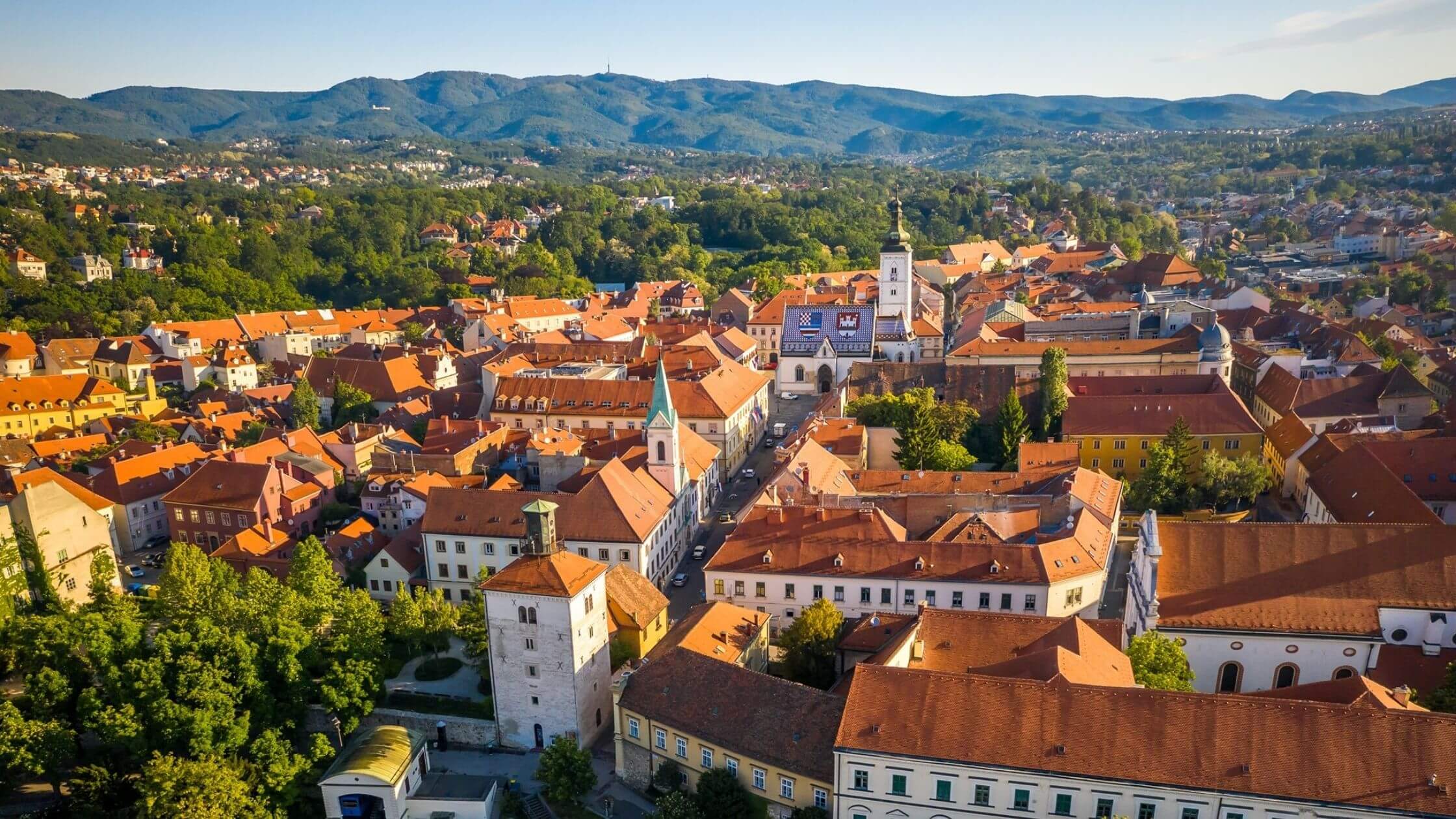
The gorgeous buildings of Upper Town in Zagreb. Visit Zagreb/Facebook.
Cultural landmarks of the city include Ban Jelačić Square which has existed since the 17th century, the Zagreb Cathedral, or the magnificent Croatian National Theater whose unveiling ceremony was attended by Austro-Hungarian Emperor Franz Joseph I. So, make sure you squeeze in some time for a walking tour to absorb the sights of Zagreb’s Old Town.
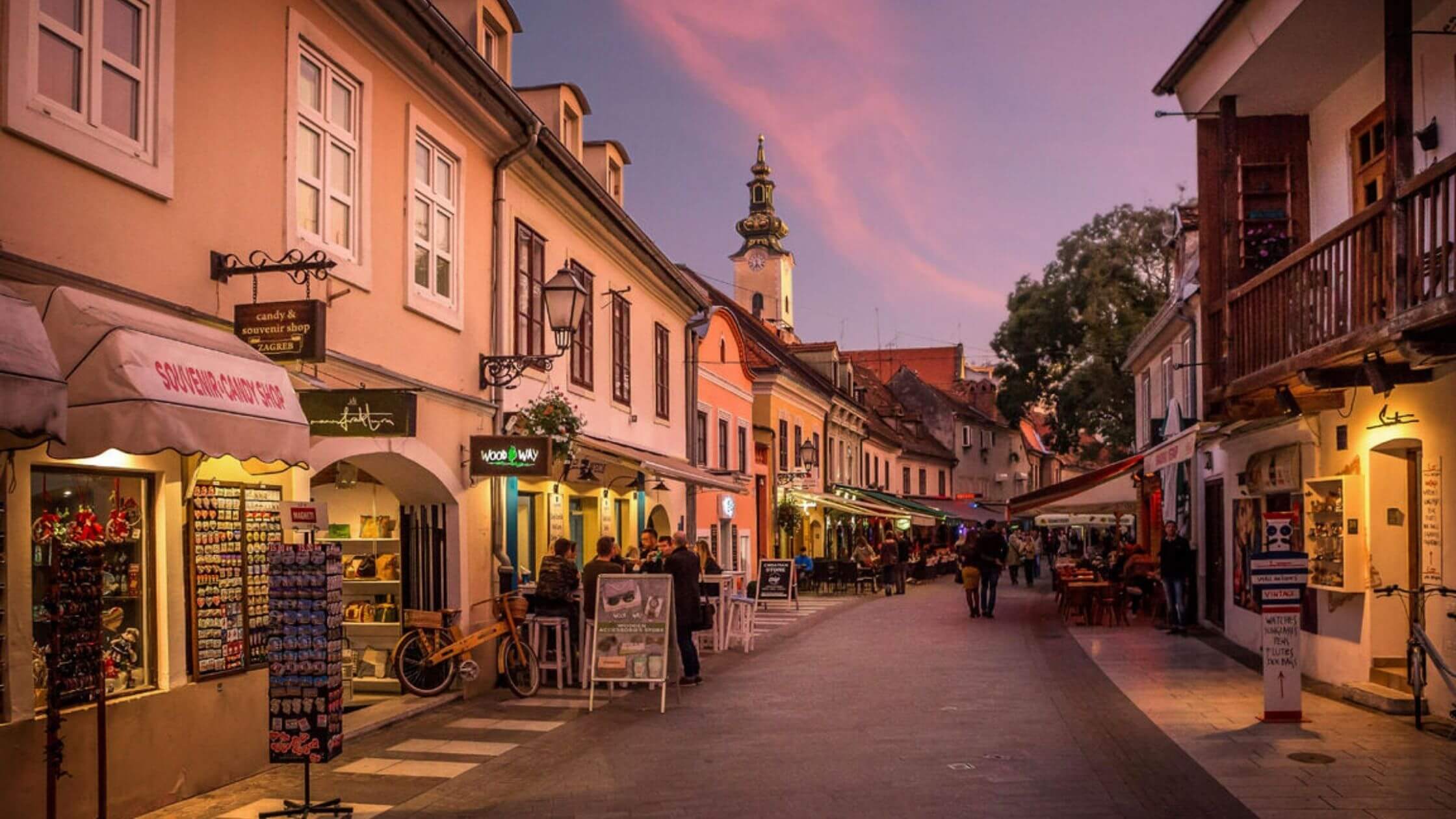
Evenings on Tkalčićeva Street, Zagreb. Visit Zagreb/Facebook.
Hungry? Head to Dolac market, Zagreb's main open-air farmers market to pick up some fresh, seasonal produce and souvenirs. You can also choose to end your day with a tasty meal and local wine from any of the excellent restaurants, bars, and cafes along Tkalčićeva Street.
Day 2: Rovinj
After a bustling day in Zagreb, the enchanting city of Rovinj is a splendid change of pace. Perfectly situated on the Istrian peninsula, the city boasts a rich heritage, from being settled by Venetian tribes, to becoming part of the Byzantine and Frankish Empires, all reflected in the diversity of the city’s architecture, art, and culture.

This stunning setting has been a popular film setting for movies such as "The Hitman's Wife's Bodyguard". Rovinj Tourist Board/Facebook.
Stroll along the beautiful cobbled streets and narrow alleys of Rovinj Old Town and make your way towards St. Euphemia Cathedral. Along the way, you should pass by Grisia Street, lined with souvenir stalls and galleries with the most unique pieces to add to your collection.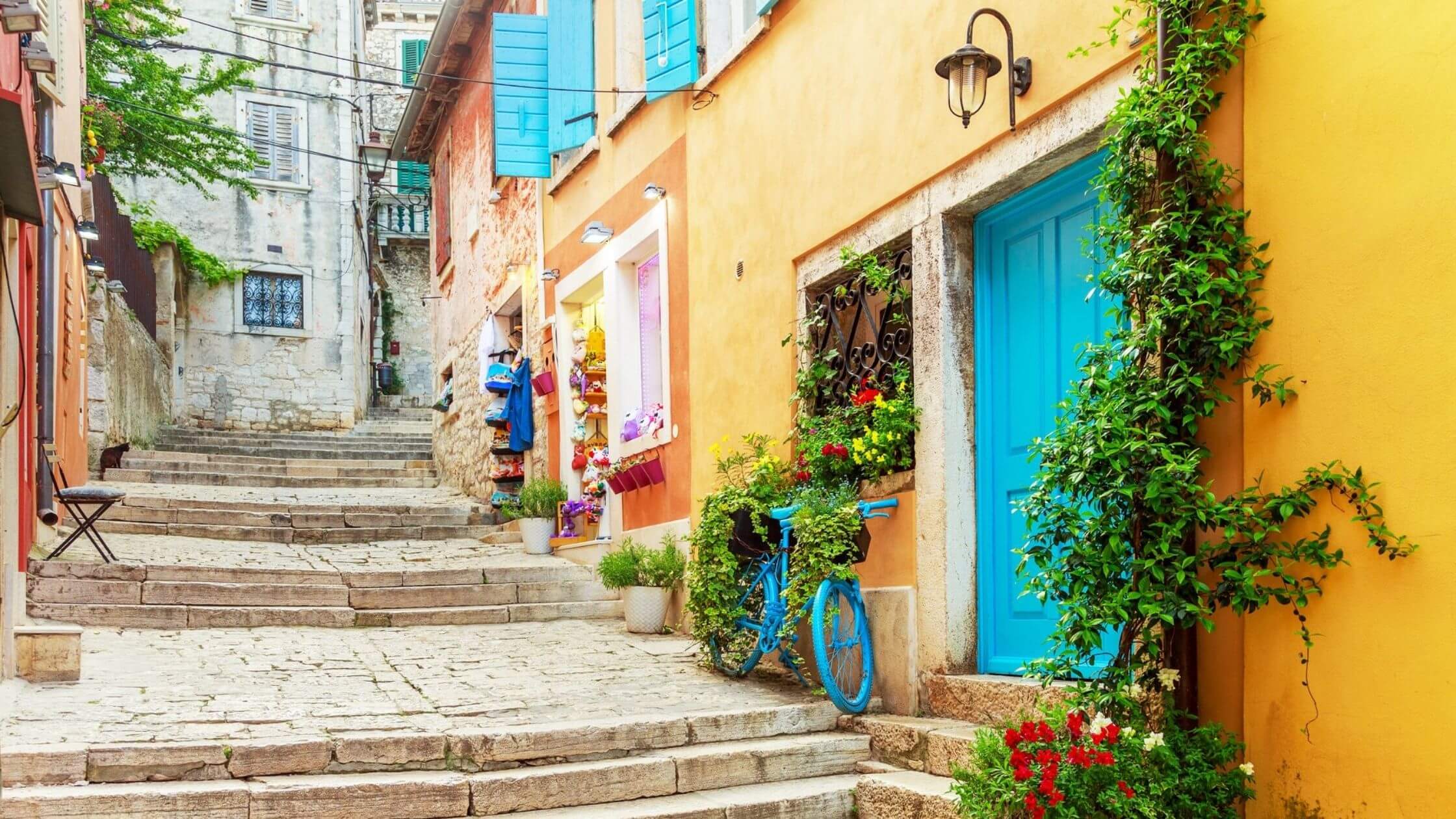
The charming, picturesque streets of Rovinj's Old Town. Rovinj Tourist Board/Facebook.
If you have time to spare, take a day trip to Sveta Katarina, a small picturesque island that’s a mere 10-minute water taxi ride from the pier. Spend the afternoon taking a dip in the aquamarine waters of the bay, or hike on one of the numerous trails dotted around the island, or both!
Alternatively, sit back and relax on some of the most beautiful beaches in Istria such as Amarin, Borik, or Valdaliso Beach.
Day 3: Pula
Before leaving the Istrian Coast, make Pula the next stop on your road trip. Serving as the capital of Istria, Pula was the main military port for the Austro-Hungarian Monarchy at the height of its military glory. Today, remnants of these times are reflected in the city’s breathtaking landscape.
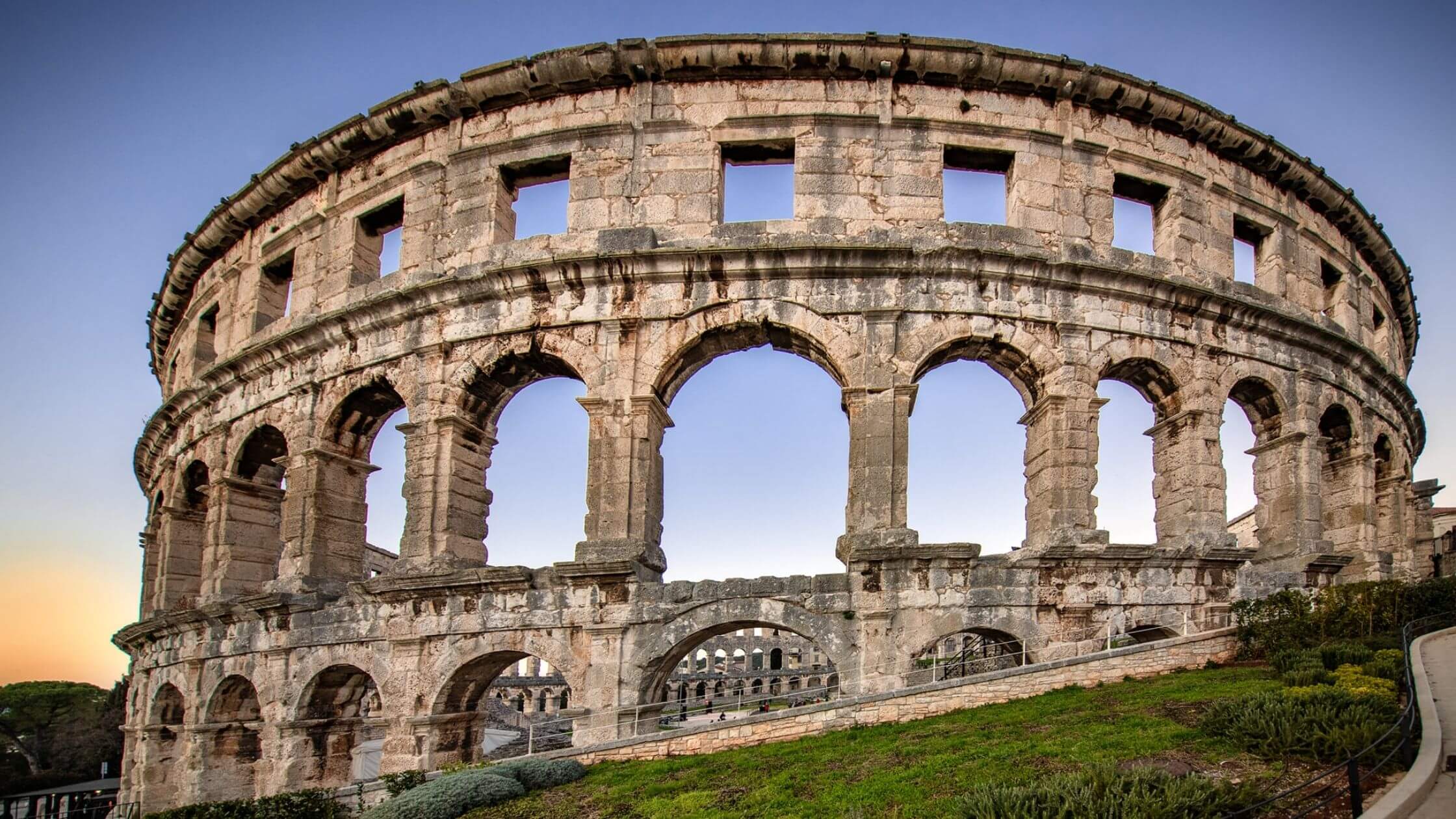
The Pula Arena frequently hosts concerts and festivals throughout the year. Pula Plus/Facebook.
The famous Pula Arena, one of the most well preserved Roman amphitheaters in the world, is a must-see! Another not to be missed landmark is the Temple of Augustus, a monument dedicated to the first Roman emperor in honor of his rule.
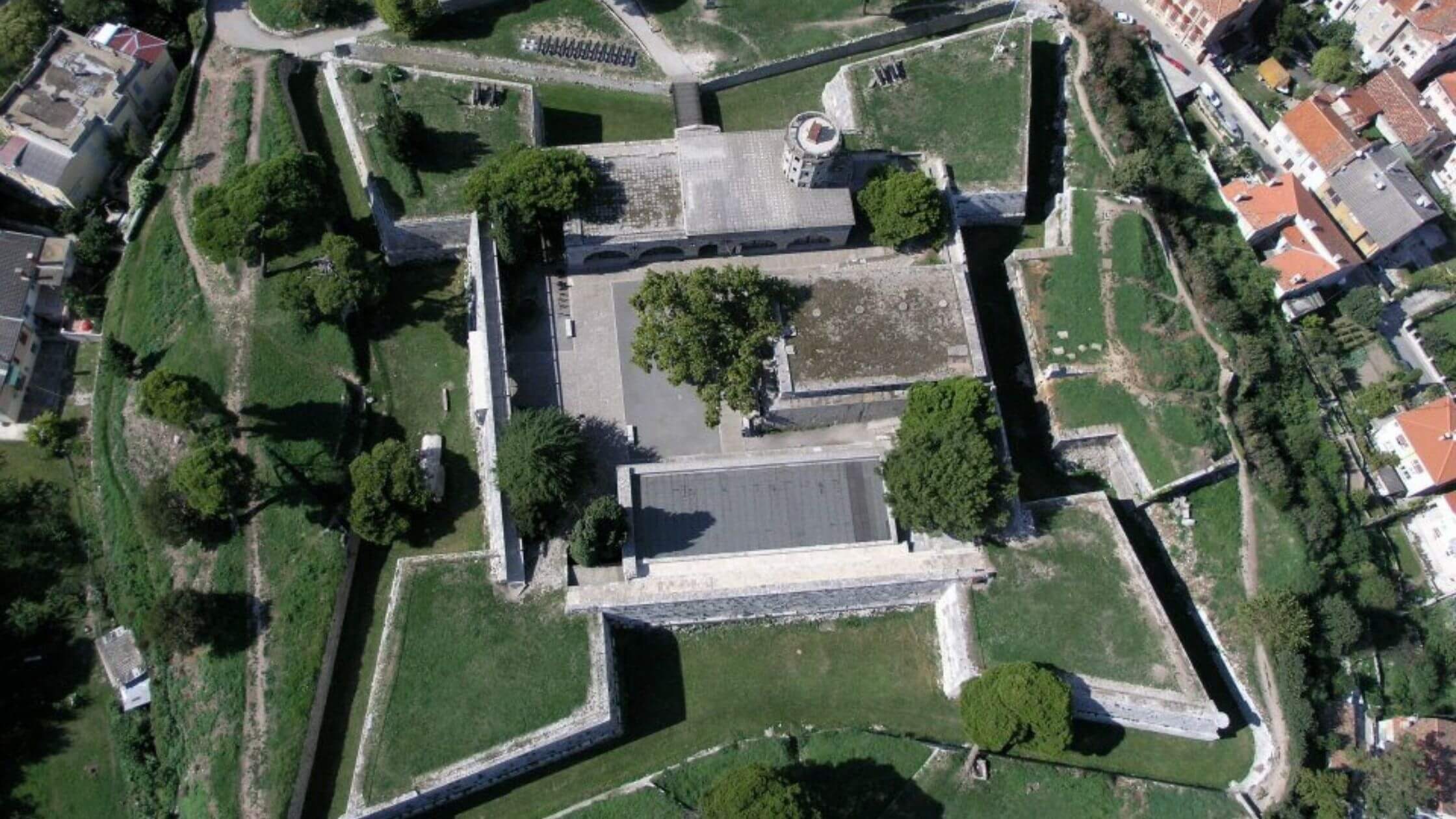
The unique shape of Fort Puna Christo. Pula Plus/Facebook.
Also check out the impressive Fort Punta Christo, which includes an underground section to explore and a well-stocked rooftop bar for refreshments after. You can also enjoy magnificent 360-degree views of Pula from the Venetian Fortress (Kaštel) which also houses the Historical and Maritime Museum of Istria.
Day 4: Plitvice National Park
Although Croatia boasts some of the best coastlines in the world, Plitvice Lakes National Park consistently appears in the top must-see places to visit in Croatia, and for good reason! This UNESCO World Heritage Site holds the title as the oldest and largest national park in Croatia, famous for its gorgeous turquoise lakes. Well worth the detour inland.
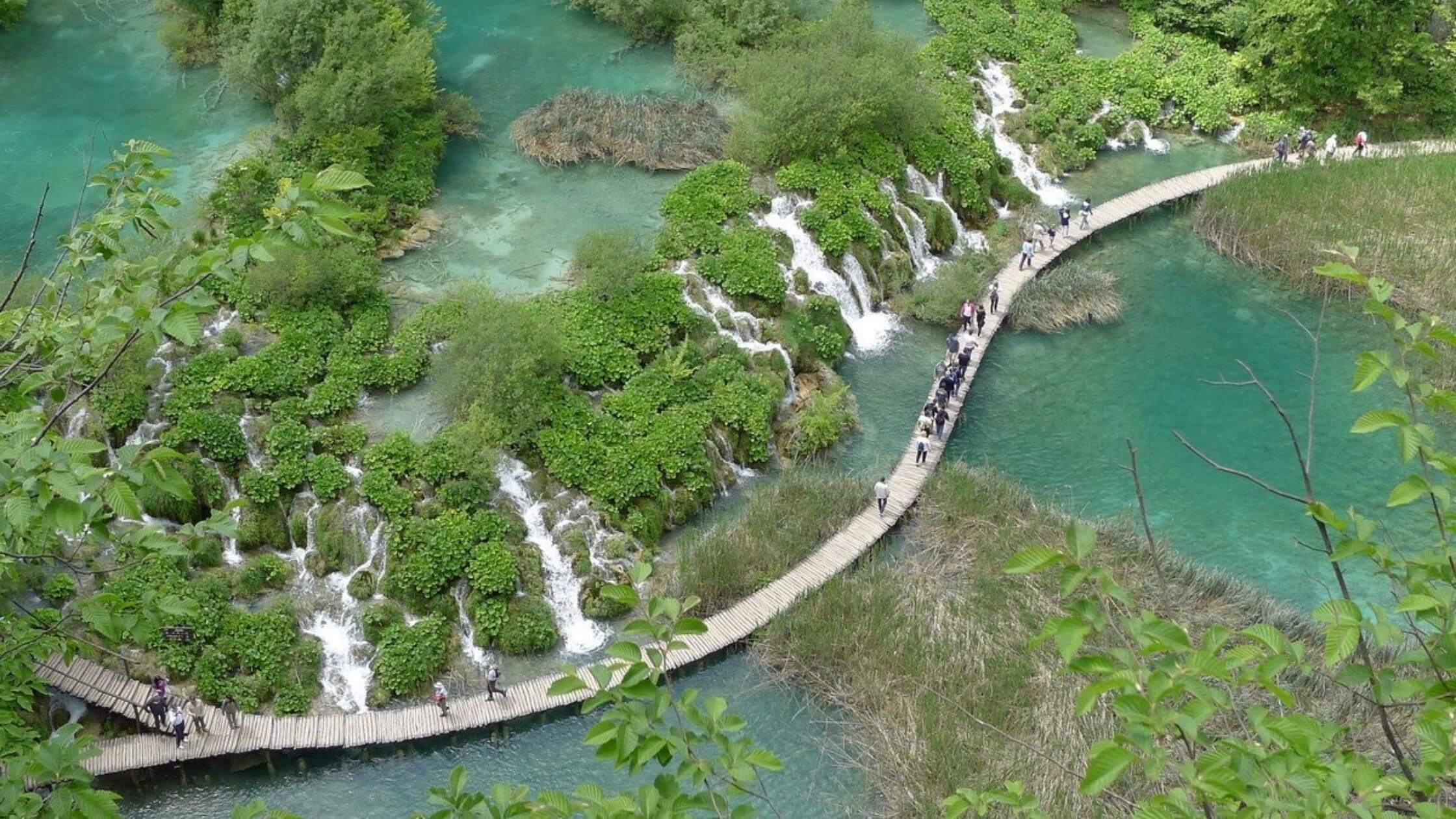 The main walkway of Plitvice Lakes National Park. Plitvice Lakes National Park/Facebook.
The main walkway of Plitvice Lakes National Park. Plitvice Lakes National Park/Facebook.
Be aware that the park can get very crowded during the season! To avoid this, just be prepared to visit early (7-8am), or better still, stop by during off-peak seasons where the park transforms into the perfect winter wonderland.
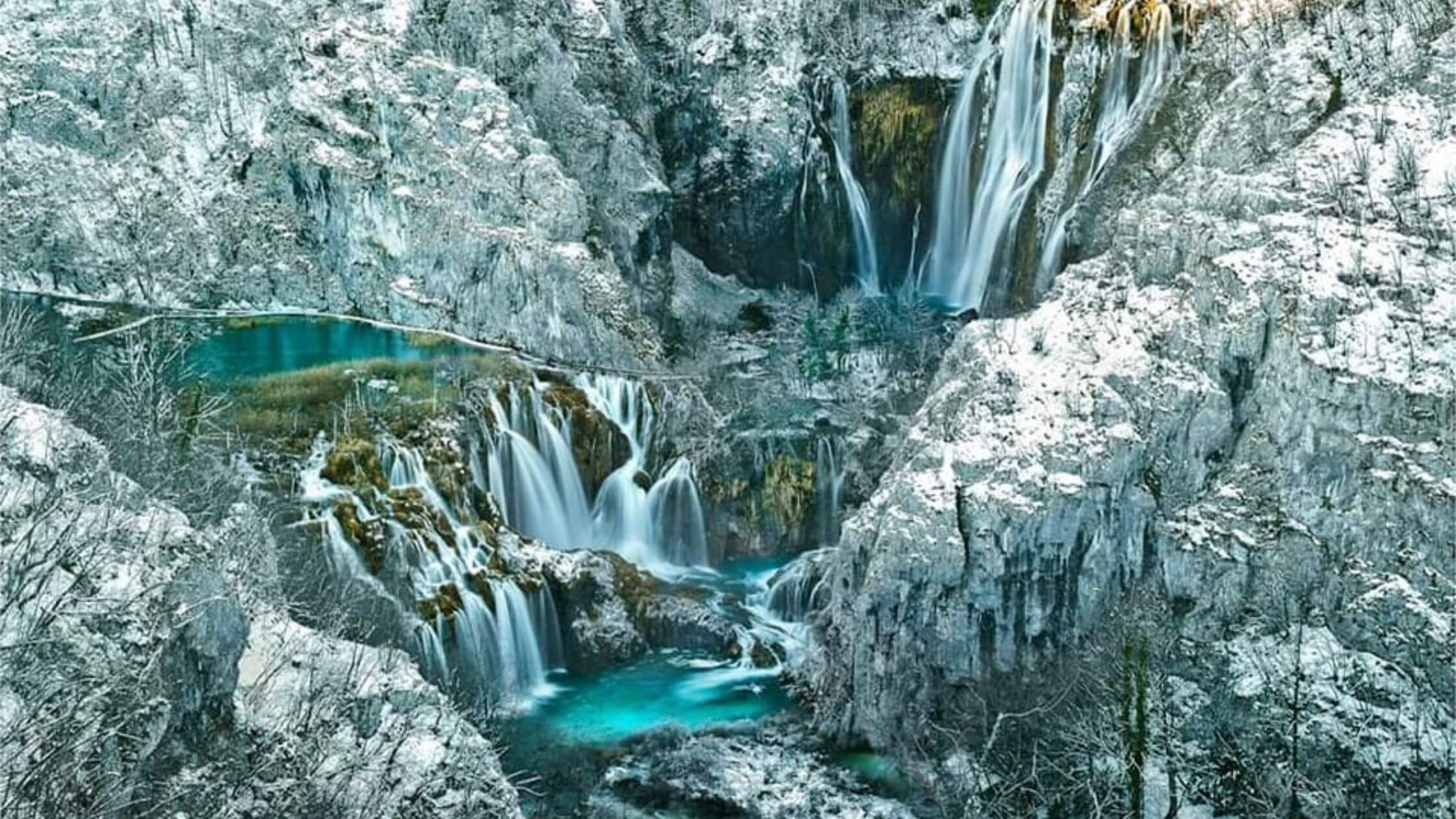
Plitvice Lakes National Park/Facebook.
Day 5: Zadar
After a day in the lush forests, take a scenic drive back to the Dalmatian coast and spend a day in the charming city of Zadar, the oldest continuously inhabited Croatian city. Today, cozy cafes and art galleries are seamlessly woven into remains from the times of Julius Caesar and Emperor Augustus.
Enjoy a relaxing stroll through Old Town and admire the historical architecture including the Church of St. Donatus, the Landward Gate, the Cathedral of St. Anastasia, and the Roman Forum.
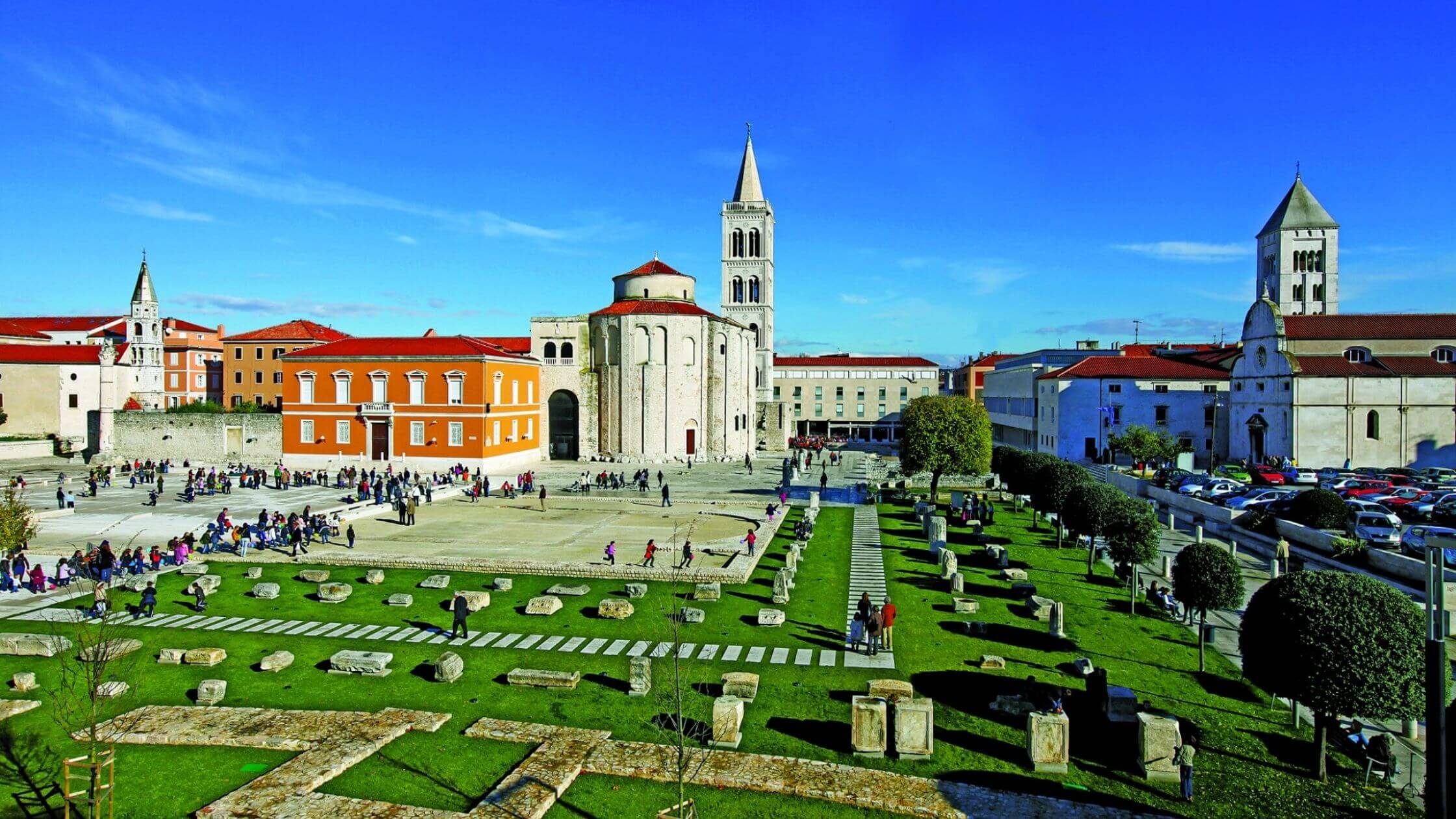
Ruins in the Old Town of Zadar. Zadar Region/Facebook
Along the way, catch the famous Sea Organ, and a sunset so beautiful, it even captivated Alfred Hitchcock! Just after sunset, take in the light show at the Sun Salutation, an installation created by Nikola Bašić, the same artist who designed the sea organ.

The Landward Gate, Zadar. Zadar Region/Facebook
If you have some time in between, head to Pag Island to try some of the famous Paski Cheese or to Nin, home to Queen’s Beach, the longest sandy beach in Croatia. Other gorgeous beaches along the coast of Zadar include Kolovare and Borik.
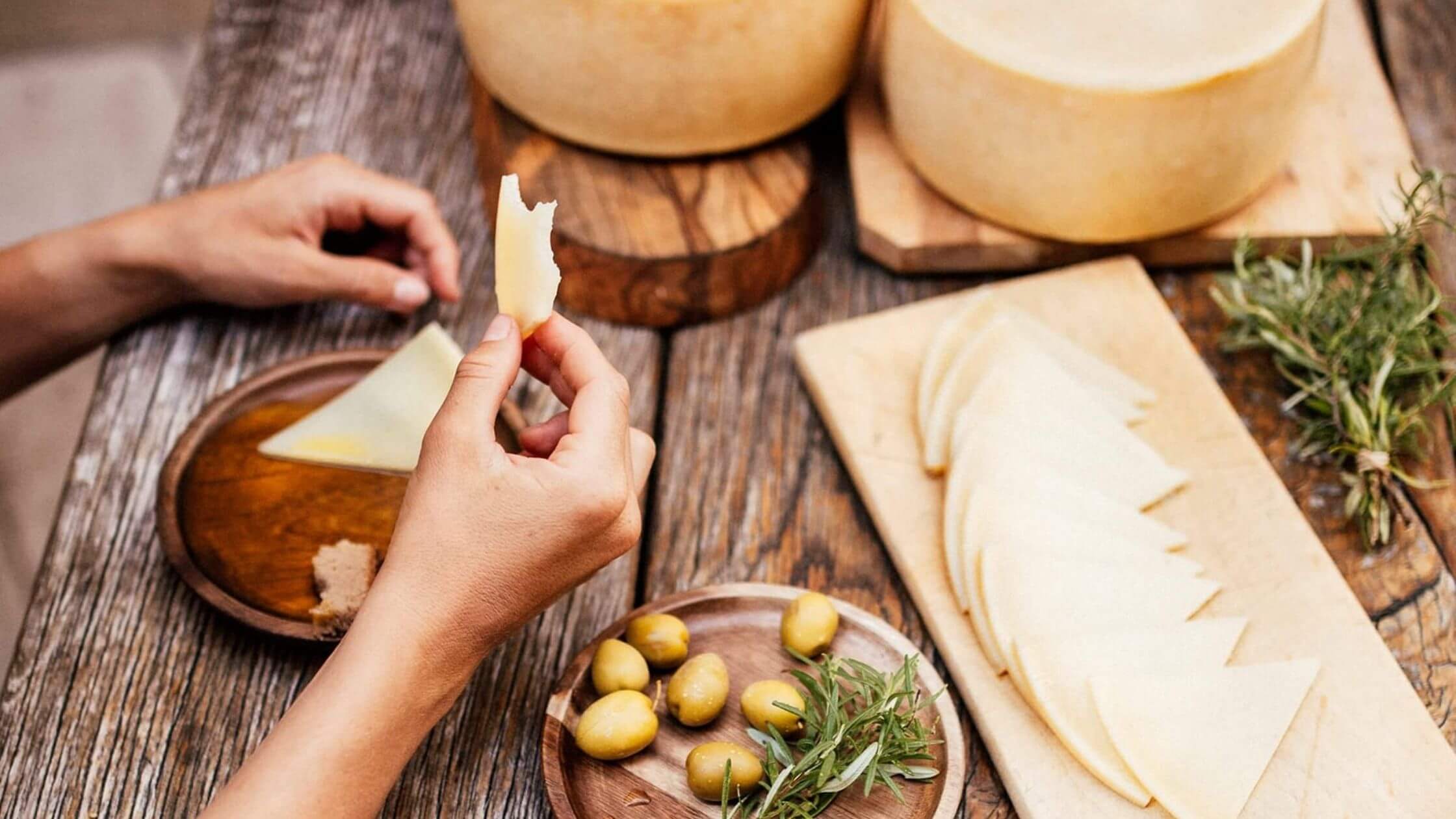
Award-winning sheep's cheese from Pag Island. Pag Tourist Board/Facebook.
Day 6: Split
Welcome to Split, the largest city in Dalmatia, and second-largest in all of Croatia. The city was founded as the Greek colony of Aspálathos between the 3rd and 2nd century BC.
It was later where Diocletian's Palace was built for the Roman emperor in AD 305. The palace also houses the Peristil, or the main square, another great place to enjoy some coffee and people-watch in addition to the Riva promenade.
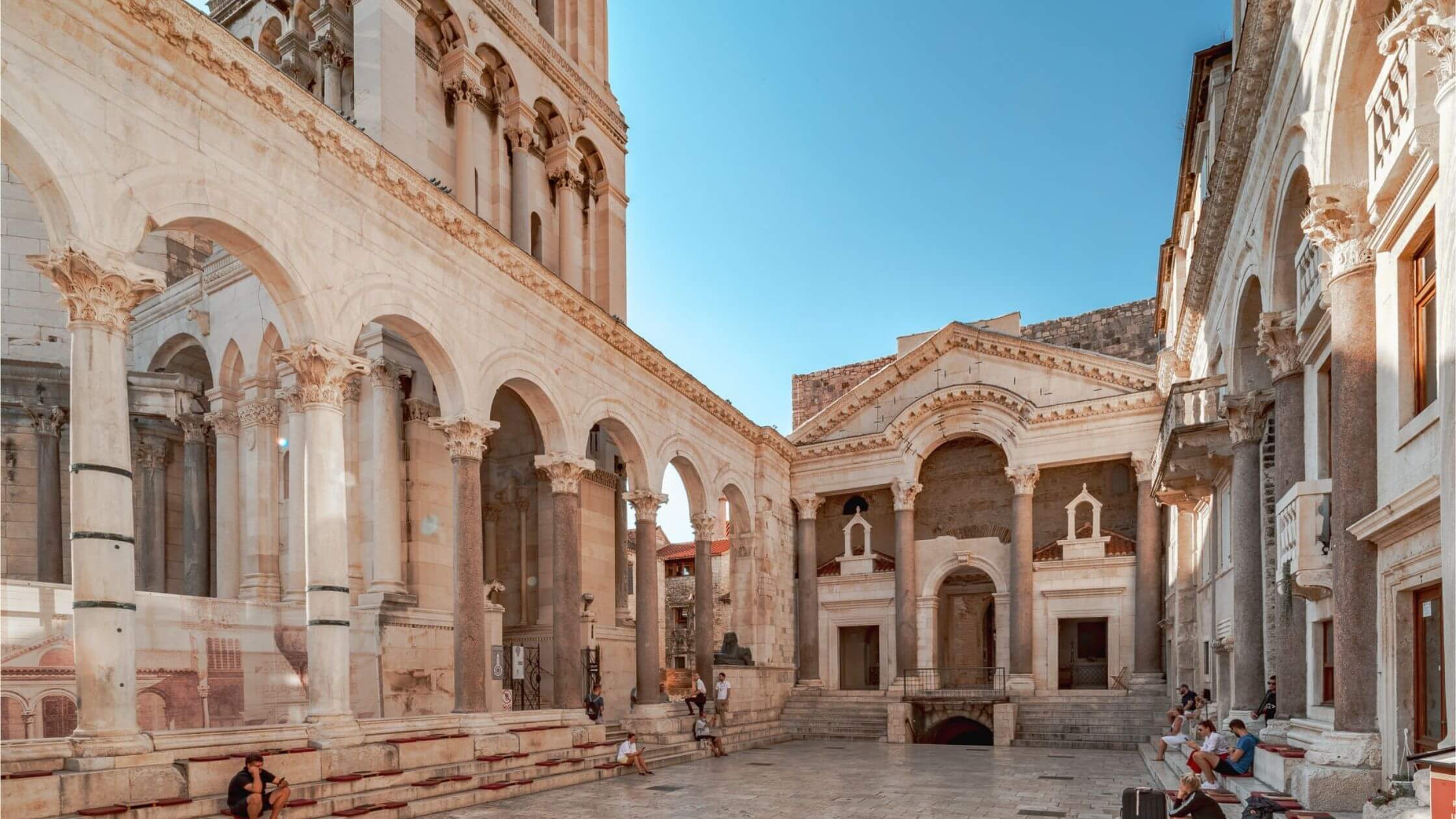
Enjoy a drink inside the walls of the Diocletian's Palace, Split. Visit Split/Facebook
While exploring the Old Town, stop by the Green Market, the largest farmer’s market in Split, to pick up some fresh, organic produce. Turn the corner and it is difficult to miss the 8.5-meter statue of Gregory of Nin, sculpted by world-renowned artist Ivan Meštrović. Rubbing the statue’s toe is said to bring good luck, so much so that it has been worn smooth by visitors over the years.
You can also squeeze in a light hike up Marjan Hill, also known as the “lungs of Split”. Its summit is an ideal place for a picnic, offering marvelous views of the harbor and neighboring islands.

The crystal clear waters of Bačvice beach. Visit Split/Facebook
Fancy another beach day? Bačvice beach is a popular hangout spot in the center of Split. Relax at one of the many cafe bars and watch the locals play picigin, a traditional ball game. Rumor has it this beach is also where the sport originates from.
Day 7: Krka/Omiš/Trogir
Don't be too quick to leave Split. From here, there are several options for day tours to surrounding attractions.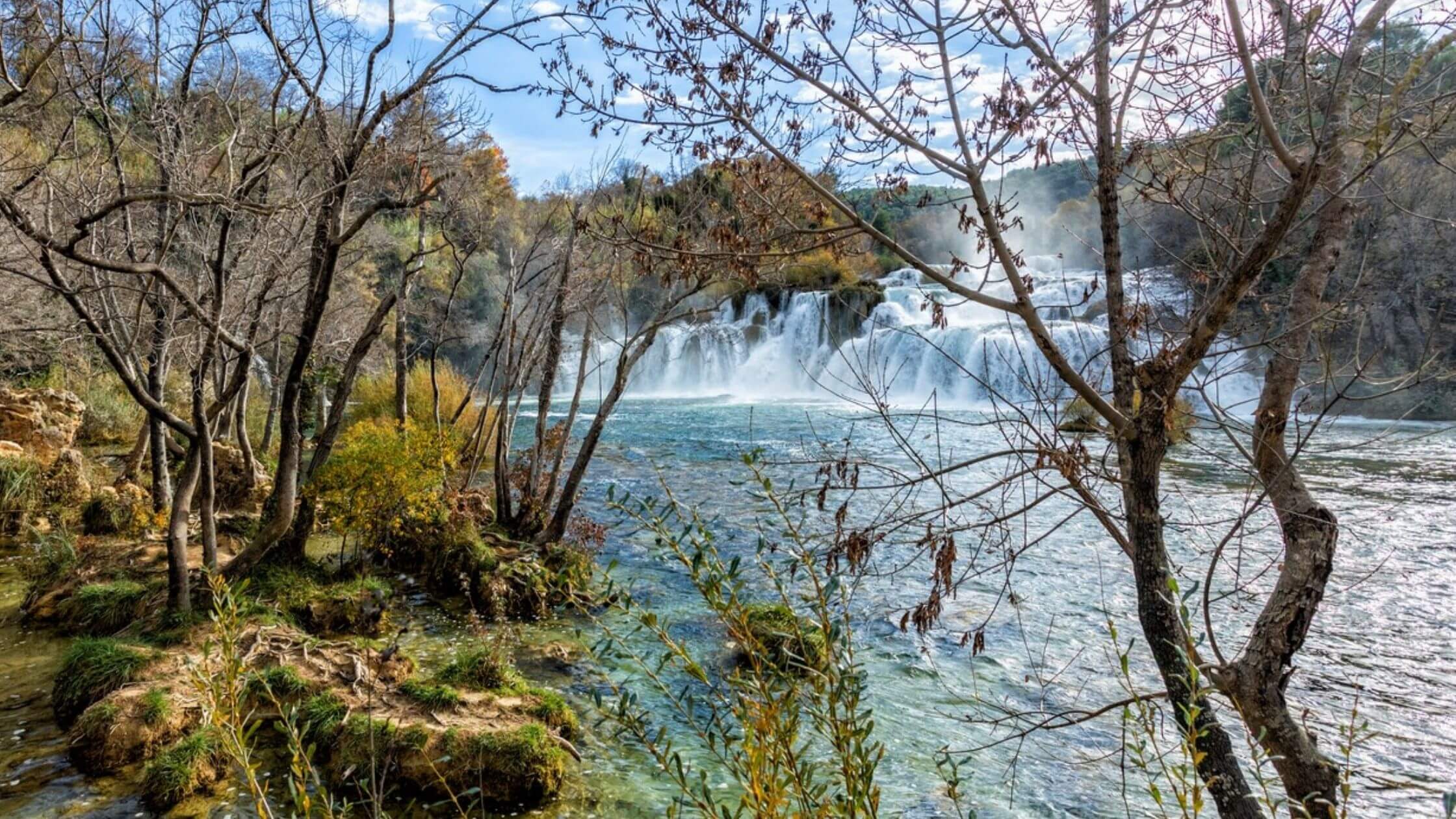
Some of the most stunning waterfalls in Croatia can be found at Krka National Park. Krka Nationa Park/Facebook
For nature lovers, Krka National Park is another national park about an hour’s drive from Split. Spend a day walking along well-maintained trails that wind along some of the most stunning waterfalls in the country. Again, make sure you get there early to avoid the crowds!

Try white water rafting in Omiš. Tourist Board Omiš/Facebook
For those craving more action, head to the picturesque town of Omiš which offers one of the most dramatic scenes on the coast. The city is nestled in a canyon surrounded by gray, craggy mountains, contrasting the peacock blue waters where the Cetina River meets the Adriatic Sea. Omiš offers white water rafting, free climbing, ziplining, abseiling, and canyoning, amongst other activities for visitors seeking a bit of a thrill on their vacation.
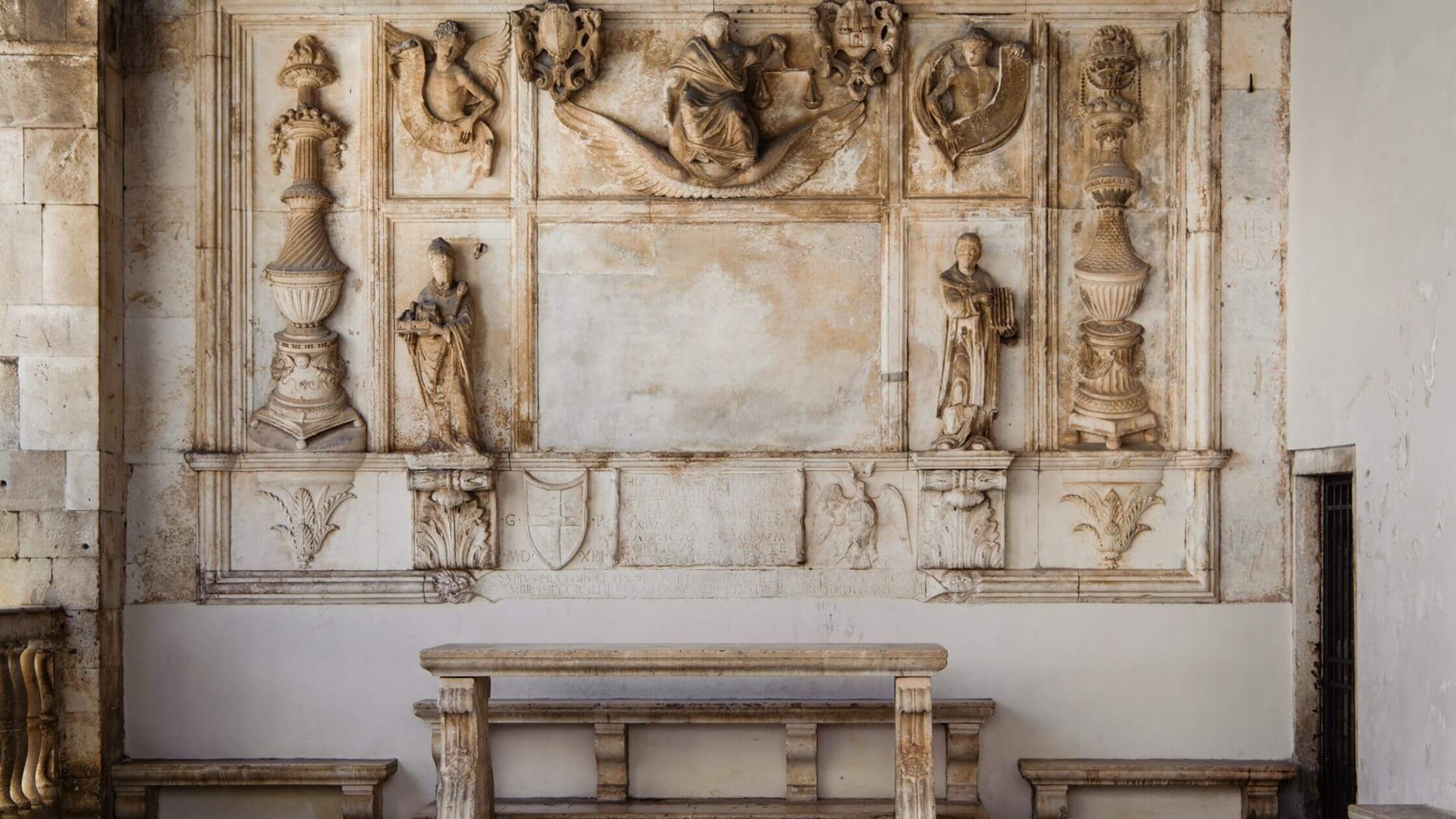
Just one of the many well-preserved remains scattered around Trogir's Old Town. Visit Trogir/Facebook
For the history buff, head to Trogir which has the best-preserved Romanesque-Gothic complex in all of Central Europe. Take a walk around the Old Town, surrounded by walls comprising a series of dwellings and palaces from the Romanesque, Gothic, Renaissance, and Baroque periods.
Day 8: Hvar
With over 1,000 islands, it wouldn’t be a complete trip to Croatia without doing some island hopping. From Split, take the 1-hour ferry ride over to Hvar. Its beauty and vibrant nightlife have made it a regular vacation spot for the likes of celebrities such as George Clooney and Beyonce.
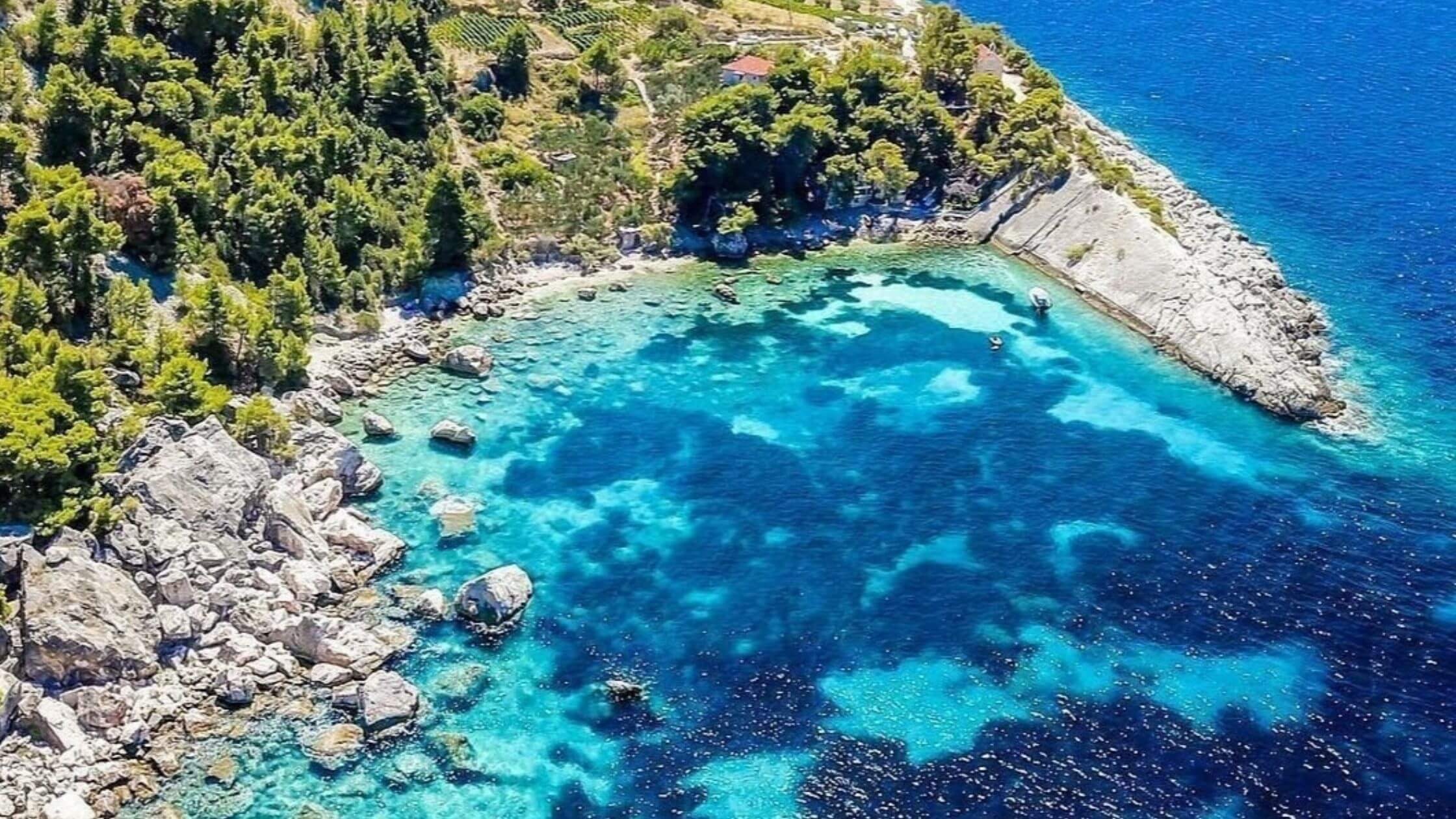
Hvar is one of the longest and sunniest islands in Croatia. Hvar Tourist Board/Facebook
Start by wandering around St. Stephen’s Square, the largest square in Croatia and don’t miss the Cathedral of St. Stephen and the Hvar public theater. For the best view, climb to the top of the Španjola Fortress to get an unobstructed view overlooking Hvar Town and nearby Pakleni Islands. You can even rent a small boat (no license required) to explore these islands on your own!
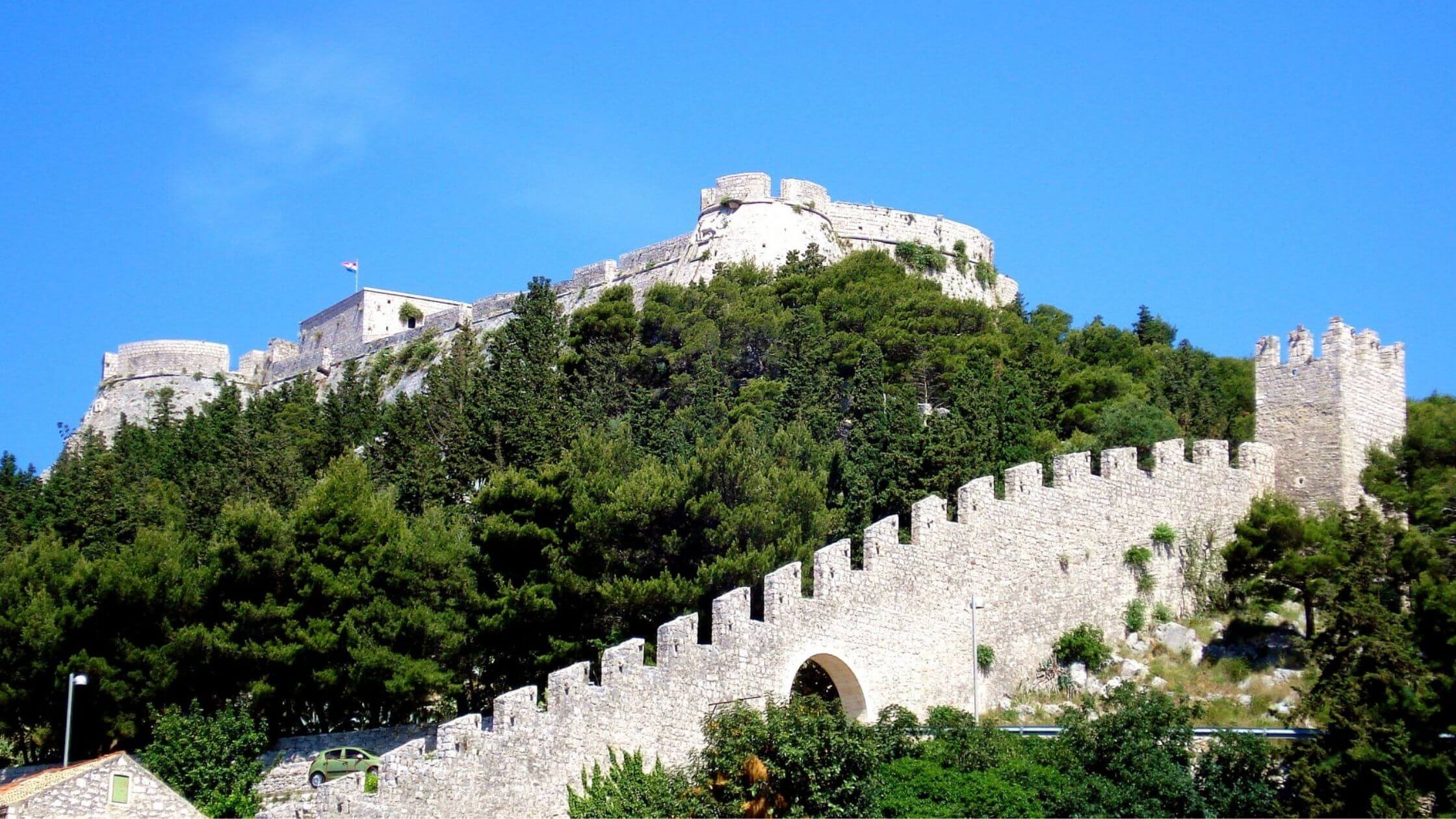
The view from the top of the Španjola Fortress is unparalleled on the island. Hvar Tourist Board/Facebook
Once you’ve taken in all these sights, enjoy another relaxing beach day at one of the many pristine beaches such as Malo Zaraće, Dubovica, or Pokonji Dol.
Alternatively, if you’re looking for another day trip, book a tour with one of the local travel agencies to the Blue Caves on Biševo and marvel at its clear, iridescent blue waters.
Day 9: Korčula
After the buzz of Hvar, take the ferry to the tranquil town of Vela Luka on the island of Korčula, the birthplace of famed explorer Marco Polo and home to some of the best Croatian wines.
From Vela Luka, take a scenic drive towards the town of Korčula, also known as “little Dubrovnik”. Along the way, stop by the numerous family-run vineyards that welcome visitors for wine and cheese tastings.
Grk is a white wine variety grown almost exclusively on Korčula, other white wines such as Pošip and Rukatac are also premier Croatian wines, often served on celebratory occasions. For fans of red wine, do grab a bottle or 2 of Plavac Mali.

Vineyards of Korčula island. Visit Korčula/Facebook
In Korčula, walk off the afternoon’s indulgences exploring the streets of the Old Town with its architectural influences by the Venetian Renaissance, before capping off the night with a meal and more wine at any of its superb restaurants.

Korčula town. Visit Korčula/Facebook
Day 10: Dubrovnik
There’s no better way to end the trip than with Dubrovnik. And yes, there is no shortage of Game of Thrones tours to indulge your senses, but there is so much more to this medieval city than where Cersei Lannister did her walk of shame.
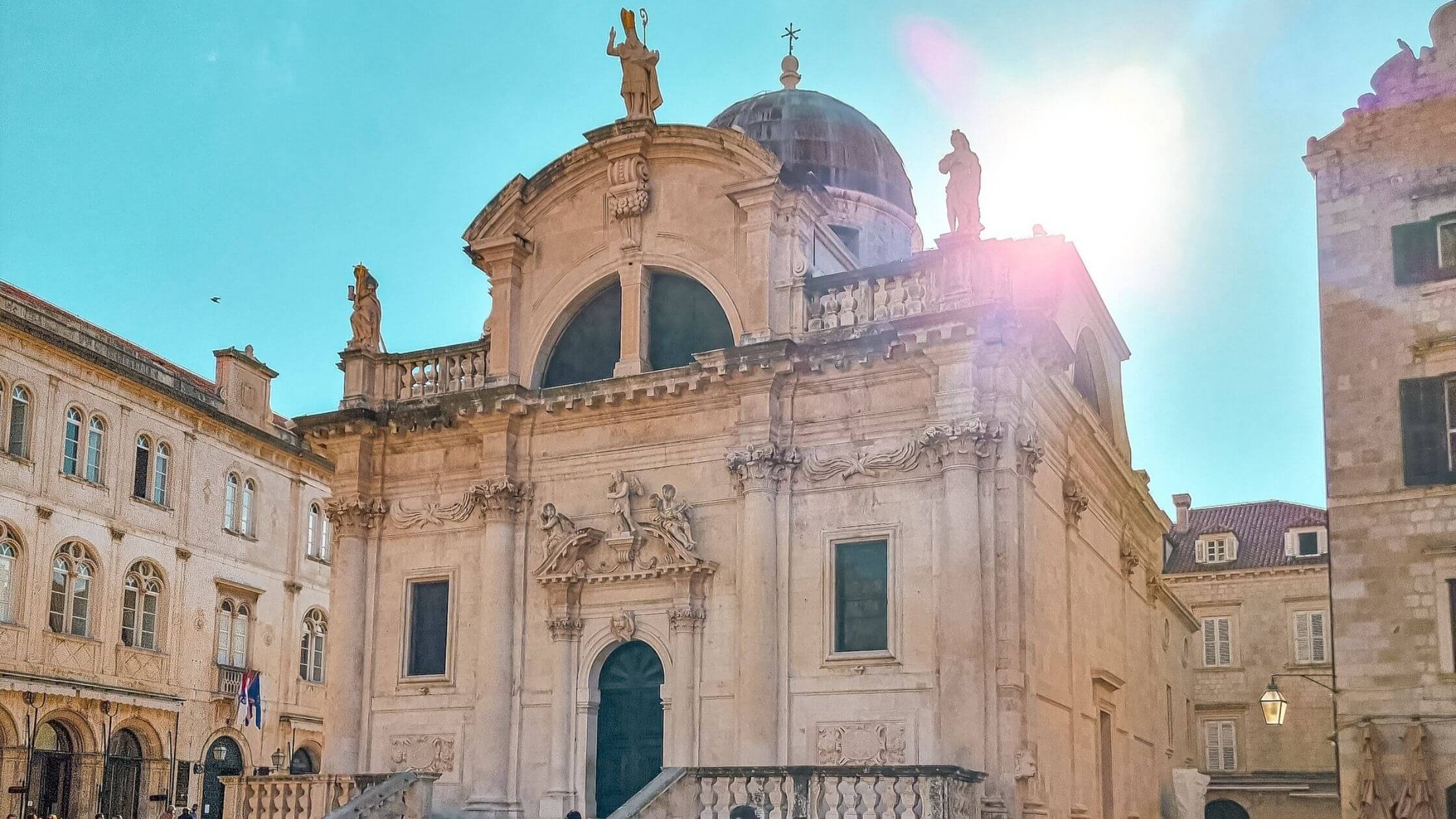
The beautiful Saint Blaise's Church in Dubrovnik was built during the 10th century. Dubrovnik Tourist Board/Facebook
Talk a walk along the city walls and through Stradun, Dubrovnik’s main street. From here, you can also catch Onofrio’s Large Fountain that used to supply Dubrovnik with fresh water during the Middle Ages and other impressive structures including the Clock Tower, Saint Blaise's Church, Saint Ignatius Church, Cathedral of the Assumption, and the Franciscan Monastery.
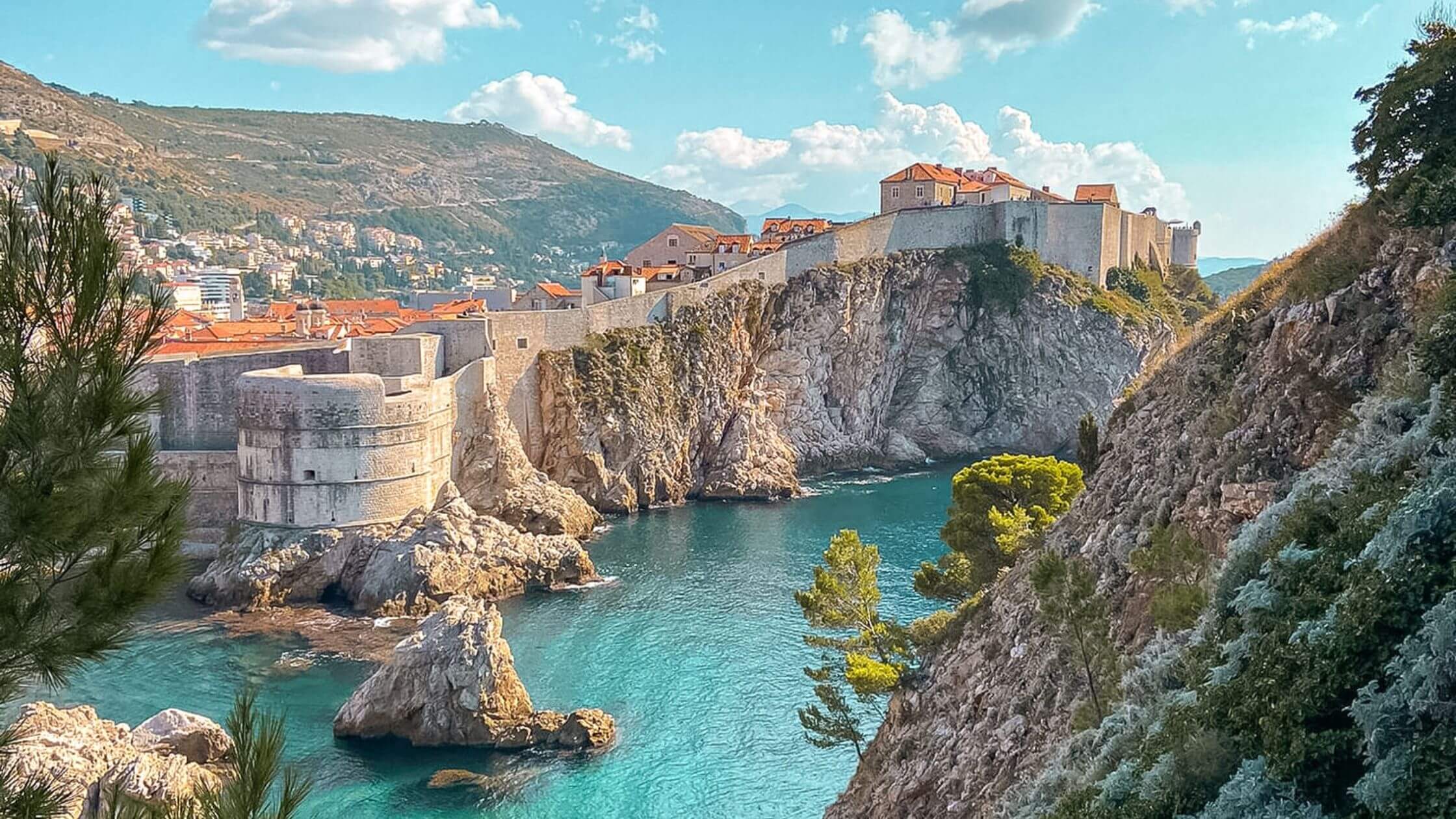
The view from beyond the walls of Dubrovnik looking upon Fort Lovrijenac. Dubrovnik Tourist Board/Facebook
Watch the sunsets and reminisce on your amazing road trip through the country at one of the cliff bars along the city walls, before capping it all off with an exquisite meal at one of the many Michelin-starred or recommended restaurants Dubrovnik has to offer.

Nothing like a luscious meal to top off a fantastic experience road-tripping in Croatia. Dubrovnik Tourist Board/Facebook
And that’s all folks, you’ve done it! Croatia in 10 days! Bear in mind, this is merely the appetizer of what Croatia has to offer. Customize this guide to better suit your tastes and pace and remember, don’t hesitate to ask the locals in order to unlock the best secrets each location has to offer.
For more on travel in Croatia, follow TCN's dedicated page.
PM Plenkovic Claims to Have Made Life for Croatian Islanders Better
January the 24th, 2022 - PM Andrej Plenkovic has claimed that his government (HDZ) has pushed life for Croatian islanders in a better direction, adding that the digital transition is a huge chance for Croatian islanders in many ways.
As Morski writes, after visiting the moonlike island of Pag and participating in the "Croatian Island Product" for 2020 and 2021 award ceremony, Prime Minister Andrej Plenkovic stressed that this initiative, which has been going on since way back in 2007, is a great example of promoting island economies, indigenousness, cuisine and agricultural products - all that makes up the true identity of not only the islands but Croatian islanders themselves.
The Croatian island product label, he added, is a guarantee of quality and originality, and is proudly placed on products from the islands of Brac, Hvar, Vis, Korcula, Pag, Krk, Lastovo, Dugi otok, Rab, Cres, Lošinj, Prvic, Ugljan, Mljet, Solta, Zirje, Pasman, Iz, Murter, Olib, Kornati, Rab, Silba and Zlarin and the Peljesac peninsula.
He pointed out that the maritime orientation of Adriatic Croatia is important for understanding Croatia and its differences, but above all - its riches and what it has to offer.
"The government wants the sustainable management of island resources"
''Croatian islands are among the riches of this country that many of our friends have come to love and appreciate. In terms of tourism, the islands are always among the most attractive destinations, visited by many tourists, and they want domestic products,'' said Prime Minister Andrej Plenkovic, talking about the meaning of the Croatian Island Product initiative which emancipates the tradition of Croatian islands and Croatian islanders in a visible and recognisable way.
He said that his government had partly continued and partly improved the strategic, legal, programmatic, project and financial framework for improving life on the islands and providing more support to Croatian islanders.
He added that the islands are also part of Croatia's National Development Strategy until the year 2030, which emphasises the direction of development of smart and sustainable islands, fully incorporated into global and European Union (EU) trends. The government also wants the sustainable management of island resources, respect for specifics and the greater availability of infrastructure and public services.
''In the future, the islands will be the focus of one of the most important global topics - the issue of climate change,'' he pointed out.
''The digital transition is a huge opportunity for Croatian islanders''
In addition to the green transition, Prime Minister Plenkovic emphasised, the digital transition is also important for the country's many inhabited islands. He said that it was a huge opportunity for island inhabitants, noting the fact that Croatia was the first to embrace digital nomads, given that today, internet platforms for work and more or less everything else can be used from anywhere in the world.
Croatia also has a National Island Development Plan, added Prime Minister Plenkovic, which aims to improve the availability of health and social services and strengthen all of the brimming potential of the islands that will have an impact on demographic trends and economic revitalisation. It will also work to further encourage the creation of the proper entrepreneurial infrastructure for island economy development, competitiveness, innovation, and increase the recognisability of island products and services. On top of that, it will work for the protection of nature and the environment and the use of renewable energy sources.
One of the key topics, Plenkovic also pointed out, is the mobility of Croatian islanders and frequent transport connections, not only from the islands to the mainland but also between the islands themselves.
He stated that 1.8 billion kuna had been invested in transport and transport connectivity, 300 million kuna had been invested in the economy and employment, 262 million kuna had been invested in agriculture, 166 million kuna in energy, 162 million kuna in water management, while when it comes to the budget, another 560 million kuna had been invested, and 206 projects worth as much as 118 million kuna had been co-financed through the Island Development Programme.
''We're going to continue to do everything to keep our people living on the islands and to make life better for them,'' he said, emphasising that fact that the island of Pag is one of the great examples of recognisability in this way.
For more, check out our lifestyle section.


